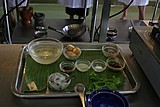Home |
Restaurants by City
|
Food Photography |
Archive | Philosophy |
![]()
Right now we are eating in Seattle, Washington.
|
Thursday
2006
Permalink
|
Blue Elephant Cooking School, Bangkok, Thailand, tasted on December 5, 2005 A semi-regular feature of any tourist adventure in Thailand (especially when visiting Bangkok or Chiang Mai) is a cooking class. I was both excited to learn some basic Thai cooking skills, and leery of a tourist trap. I told myself that I would find some small hip cooking school that was off the beaten track in terms of tourists. Unsurprisingly, I failed. After the 27th time when I tried to get someone to recommend me the little known authentic Thai cooking class, and the response was "Blue Elephant Cooking School. It's the most famous." I gave in. Besides, they had a class that started off with a trip to the market. And that seemed like a nice way to start. The Blue Elephant Cooking School is located in a cool colonial style building (note: not sure if this is an appropriate characterization as Thailand is the only country in the immediate vicinity that was never colonized) on this small parcel of land surrounded by the tumult and height of Bangkok. The first hour or so of our class was spent heading to a local market. I thought we would buy the ingredients we were going to cook. But in retrospect that was silly. The Blue Elephant had their act together and already had all the ingredients we needed. Our trip to the market was most informational though not functional and that was ok. Then it was back to the school for some instruction and hopefully cooking. It turns out, that despite being the "most famous" cooking school, the class was pretty enjoyable. Even though we were on rails (the ingredients had mostly been prepped for us) my dishes came out as good or better than most Thai food I've had in the U.S. The chef kept repeating this as well showing his disdain for the quality of many Thai restaurants. I was worried at the beginning when we entered a standard classroom setting that we'd only be watching him cook, but after each demo we went to a kitchen across the room where we got to cook ourselves. It was cool. One weird moment was when he warned us about the unripe papaya juice saying it would hurt our eyes and stain our clothes but it was ok to eat. I guess unripe papaya juice is essentially edible bleach. We learned and cooked several dishes including:
Green Chicken Curry (Keang Keaw Wan Kai),
Sour and Spicy Prawn Soup (Tom Yam Koong),
Stir Fried Rice Noodles (Phad Thai), and
Green Papaya Salad (Som Tam). The chef really took the time to
try to articulate what the flavor of each dish should be. He'd
learned Thai cooking at his mother's side and had many years as a
professional chef. I remember him going on at length about how the
sweet flavor should never come first on your tongue. For me this was
huge. Thai food is one of those cuisines (like Mexican) where the
uninitiated joke about how it's the same seven
|
|||
Our Sponsors
Free Car Listings Hot Tubs Stools Saunas Bar Stools - Calendar and Event Schedules - Food Events and Calendars - Wine Events and Calendars - Digital Photography Resources - Software for Advertisers - Jewish Gifts and Judaica - Howard Stern Podcast - ponytailed blogger Jonathan Schwartz

Browse tastingmenu
Home |
Restaurants by City X |
Food Photography |
Archive | Philosophy |
![]()
Free eBooks: All About Apples
| Autumn Omakase
More:
Discussion |
Cool Food T-Shirts |
Ingredients
| Markets |
Recipes
Search |
Blog FAQ |
Other
Blogs
Best of tastingmenu
|
City View
Entry: July 6, 2006 |
Blue Plate
Entry: June 19, 2006 |
L'Atelier de Joël Robuchon
Entry: July 18, 2006 |
Browse by City
Boston | Chicago | Houston | Las Vegas | Los Angeles | Maui | New York | Philadelphia | Portland | San Francisco | Seattle | Toronto | Utah | Vancouver | Washington D.C.
Bangkok | Beijing | Hong Kong | Seoul | Tokyo
Amsterdam | Berlin | Italy | London | Madrid | Paris | Vienna
Browse by Month
2006
2005
2004
2003
2002
2001
Comments, questions, or feedback:
info / at / tastingmenu / dot / com
All pages Copyright (c) 2001-2006 tastingmenu.com
Last modified 01/30/07.





